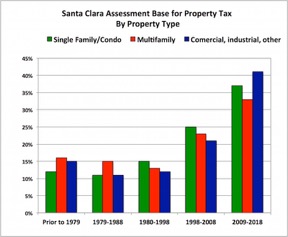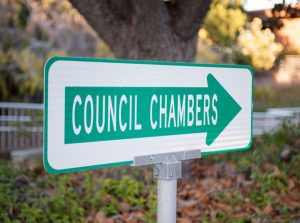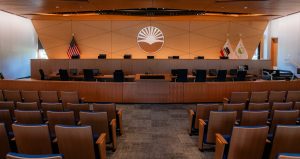Despite the new attention-getting office campuses that continue to sprout in Silicon Valley, homeowners still carry the largest share of property tax burden, thanks to the continuing legacy of Prop 13. There’s some irony here: Prop 13 passed because voters thought it would protect homeowners from being taxed out of home ownership.
When the property tax-capping law went into effect in 1979 the Santa Clara County property tax burden was evenly split between commercial and residential property.
Four decades later — during which Silicon Valley commercial and industrial development exploded — homeowners shoulder 65 percent of the property tax burden while commercial property owners’ share has dropped to only 35 percent, according to the County Assessor’s annual report (www.sccassessor.org).
“We gave the [tax] benefit to businesses as well as homeowners,” County Assessor Larry Stone told the Weekly in 2018. “Businesses weren’t suffering the hardships homeowners faced from rapidly rising property tax bills as Silicon Valley real estate values began to skyrocket in the 1970s.”
For example, the land under Intel’s headquarters in Santa Clara is assessed for $225,000 an acre, according to the Assessor’s report.
At the same time, Adobe paid $27 million an acre for the land for its new San José offices.
Howard Jarvis, Prop 13’s mastermind, is a former Executive Director for the Los Angeles Apartment Association, whose members are among the biggest beneficiaries from Prop 13. Jarvis also promoted Proposition 13 in 1978 as the real answer to skyrocketing rents — instead of rent control.
Currently, 31 percent of apartment complexes are assessed at pre-1988 values, compared with 26 percent of commercial properties and 23 percent of single-family homes.
The reason for the disparity is that businesses have many avenues for avoiding assessment-triggering changes in ownership — mergers, equity buyouts, complex ownership schemes.
“You couldn’t devise a more unfair property tax system if you tried,” Stone said. “It punishes young people. [California] home ownership is at its lowest level since 1967.”
Several public interest groups have joined together to move forward a 2020 ballot measure to create a “split roll”— keep Prop 13 protections for homeowners but allow commercial property to be assessed at current values, rather than the purchase price.
Opponents of split roll see a silver lining in Prop 13’s inequity cloud. They say its helps keep companies like Intel and Owens Corning in Santa Clara paying the business sales taxes that are the other main source of revenue for the City.
For more about Prop 13 and its effects:
The California Legislative Analyst’s Office published a study in 2016 about the effects of Prop 13: lao.ca.gov/Publications/Report/3497
In 2010 the California Tax Reform Association did an exhaustive study of Prop 13’s tax-shifting effect and California’s commercial property tax-avoidance loopholes: tinyurl.com/caltaxreform-2010rpt.
Daniel A. Smith Ph.D. of the University of Denver analyzed the Prop 13 campaign in his 1997 paper, “Howard Jarvis, Populist Entrepreneur: Re-evaluating the Causes of Proposition 13.” Smith’s conclusion: Prop 13 was “faux populist” movement: “populist-sounding solutions to societal problems” “without educative or political” engagement and promoted by politicians: tinyurl.com/jarvis-populist-entrepreneur.
California school children also carry the burden of Prop 13. In 1979 California education spending dropped dramatically, beginning California’s descent from 14th in national education spending to 41st. http://www.kpbs.org/news/2010/mar/26/prop-13s-impact-schools/












0 comments